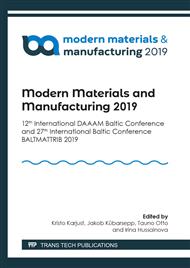[1]
A. Kazemian, X. Yuan, E. Cochran, B. Khoshnevis, Cementitious materials for construction-scale 3D printing: Laboratory testing of fresh printing mixture, Constr. Build. Mater. 145 (2017) 639–647.
DOI: 10.1016/j.conbuildmat.2017.04.015
Google Scholar
[2]
N. Khalil, G. Aouad, K. El Cheikh, S. Rémond, Use of calcium sulfoaluminate cements for setting control of 3D-printing mortars, Constr. Build. Mater. 157 (2017) 382–391.
DOI: 10.1016/j.conbuildmat.2017.09.109
Google Scholar
[3]
G. Ma, Z. Li, and L. Wang, Printable properties of cementitious material containing copper tailings for extrusion based 3D printing, Constr. Build. Mater., 162 (2018) 613–627.
DOI: 10.1016/j.conbuildmat.2017.12.051
Google Scholar
[4]
Y. Weng, M. Li, M. J. Tan, S. Qian, Design 3D printing cementitious materials via Fuller Thompson theory and Marson-Percy model, Constr. Build. Mater. 163 (2018) 600–610.
DOI: 10.1016/j.conbuildmat.2017.12.112
Google Scholar
[5]
S. C. Paul, Y. W. D. Tay, B. Panda, M. J. Tan, Fresh and hardened properties of 3D printable cementitious materials for building and construction, Arch. Civ. Mech. Eng. 18 (2018) 311–319.
DOI: 10.1016/j.acme.2017.02.008
Google Scholar
[6]
T. T. Le, S. A. Austin, S. Lim, R. A. Buswell, A. G. F. Gibb, T. Thorpe, Mix design and fresh properties for high-performance printing concrete, Mater. Struct. Constr. 45 (2012) 1221–1232.
DOI: 10.1617/s11527-012-9828-z
Google Scholar
[7]
Z. Malaeb, H. Hachem, A. Tourbah, T. Maalouf, N. El Zarwi, F. Hamzeh, 3D Concrete Printing: Machine and Mix Design, Int. J. Civ. Eng. Technol. 6 (2015) 14–22.
Google Scholar
[8]
B. Panda, S. Chandra Paul, M. Jen Tan, Anisotropic mechanical performance of 3D printed fiber reinforced sustainable construction material, Mater. Lett. 209 (2017) 146–149.
DOI: 10.1016/j.matlet.2017.07.123
Google Scholar
[9]
T. D. Ngo, A. Kashani, G. Imbalzano, K. T. Q. Nguyen, D. Hui, Additive manufacturing (3D printing): A review of materials, methods, applications and challenges, Composites Part B: Engineering. 143 (2018).
DOI: 10.1016/j.compositesb.2018.02.012
Google Scholar
[10]
N.B. Uriev Fizikohimicheskaya dinamika strukturirovannyh nanodispersnyh sistem i nanodispersnyhkompozicionnyh materialov. Chast 1 [Physico-chemical dynamics of structured nanodispersed systems and nanodispersed composite materials. Part 1]. Fizikohimiya poverhnosti i zashchita materialov. 46 (2010) 3-23. (rus).
Google Scholar
[11]
V.V. Yaminskij, V.A. Pchelin, E.A. Amelina, E.D. Shchukin Koagulyacionnye kontakty v dispersnyh sistemah [Coagulation contacts in dispersed systems] Chemistry, Moskow,1982. (rus).
Google Scholar
[12]
P.A. Rebinder Izbrannye trudy. Poverhnostnye yavleniya v dispersnyh sistemah. Fiziko-himicheskaya mekhanika [Selected Works. Surface phenomena in dispersed systems. Physico-chemical mechanics]. Science, Moskow,1979. (rus).
Google Scholar
[13]
G.S. Slavcheva, O.V. Artamonova The rheological behavior of disperse systems for 3d printing in construction: the problem of control and possibility of «nano» tools application, I-J.Nanotechnol. in Const. 10 (2018) 107- 122. (rus).
DOI: 10.15828/2075-8545-2018-10-3-107-122
Google Scholar
[14]
Z. Toutou, N. Roussel, C. Lanos, The squeezing test: A tool to identify firm cement-based material's rheological behaviour and evaluate their extrusion ability, Cem. Concr. Res. 35 (2005) 1891–1899.
DOI: 10.1016/j.cemconres.2004.09.007
Google Scholar
[15]
A. Perrot, D. Rangeard, A. Pierre, Structural built-up of cement-based materials used for 3D-printing extrusion techniques, Mater. Struct. 49 (2016) 1213–1220.
DOI: 10.1617/s11527-015-0571-0
Google Scholar



